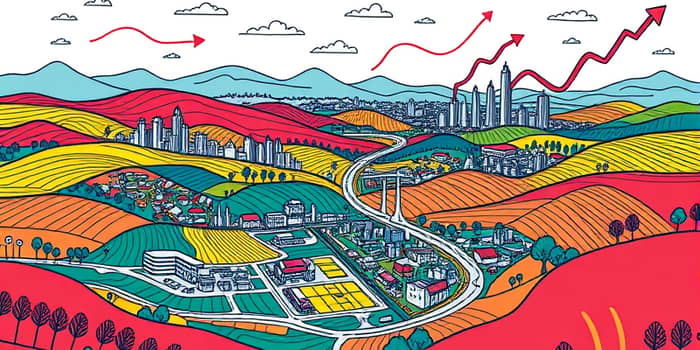
Credit strength is crucial for individuals, businesses, and governments. It reflects the ability to meet debt obligations under changing economic conditions. Understanding how broader economic shifts shape credit quality helps stakeholders navigate risk, seize opportunities, and build resilience.
Credit strength refers to the likelihood that borrowers can fulfill their debt commitments. It depends on credit history, collateral, and external forces beyond individual control. When macroeconomic conditions shift, they can either bolster repayment capacity or exacerbate default probabilities.
Key macro indicators shape interest rates, income levels, and market sentiment. Lenders and investors constantly adjust risk assessments based on these signals, striving to maintain balance between growth and stability.
GDP growth is the backbone of economic health. Rising GDP typically signals higher corporate profits, wage gains, and improved tax revenues, which in turn enhance borrowers’ capacity to repay debt. During expansions, banks often loosen underwriting standards, encouraging credit flows.
Conversely, when GDP contracts, delinquencies rise and lenders tighten credit. Historical data show that negative growth exerts a stronger effect on default rates than positive expansions, especially in cyclical sectors like construction and real estate.
Inflation erodes purchasing power, making debt-service more burdensome in real terms. Consumers and corporations face rising input costs and reduced disposable incomes. Persistent inflation often triggers central banks to raise policy rates, amplifying borrowing costs.
Across nearly all sectors, high inflation correlates with heightened credit risk. Lenders respond by revising interest margins and tightening collateral requirements to shield loan portfolios from value erosion.
Central banks use interest rates to cool or stimulate economic activity. When rates climb, variable-rate borrowers face higher debt service, weakening credit strength. Sectors heavily reliant on leverage—real estate, utilities, and corporate finance—are particularly sensitive to rate hikes.
In low-rate environments, unconventional tools such as quantitative easing and credit easing can inject liquidity into markets, lower risk premiums, and support credit availability. However, these policies can also mask underlying vulnerabilities and distort price signals over time.
Rising unemployment reduces household incomes and raises the risk of consumer credit defaults. As layoffs mount, auto loans, credit cards, and mortgages see increased delinquency rates. Lenders track unemployment trends closely to anticipate portfolio stress and adjust provisions.
Higher joblessness often precipitates a drop in consumer spending, further pressuring revenue streams for retailers and service providers, thereby weakening their credit profiles.
Fluctuations in currency values affect companies with foreign-currency debt. A weakening domestic currency raises the local cost of servicing foreign obligations, straining credit strength in export-oriented sectors. Manufacturers and miners often face higher repayment burdens.
By contrast, sectors with minimal foreign exposure—retail, agriculture, and local services—may experience pricing advantages when the currency depreciates, potentially mitigating credit strain.
The Consumer Confidence Index (CCI) captures public sentiment about future economic prospects. High confidence encourages borrowing and spending, boosting credit demand and improving repayment capacity. Falling confidence leads households to cut back, increasing precautionary defaults.
Lenders monitor CCI trends to gauge likely shifts in consumer credit performance, adjusting credit lines and interest rates preemptively.
Credit risk often spikes quickly during downturns but recovers more slowly during expansions, creating asymmetric effects that lenders must navigate carefully.
In economic upturns, banks expand credit, reduce spreads, and take on incremental risk to support growth. During downturns, they tighten underwriting, raise loan-loss provisions, and strengthen capital buffers. Proactive measures include dynamically adjusting lending criteria and stress testing portfolios.
Effective risk management hinges on scenario analysis and early warning systems that integrate macro forecasts with borrower-specific data.
Governments and central banks deploy fiscal and monetary tools to stabilize credit markets. Expansionary fiscal measures—tax relief, direct grants, and subsidies—can alleviate borrower stress and shore up credit quality. Monetary interventions such as asset purchases aim to restore liquidity and confidence.
During the 2008 financial crisis and the 2020 pandemic downturn, coordinated policy efforts were critical in preventing widespread defaults and preserving systemically important institutions.
These strategies help stakeholders navigate macro volatility and safeguard credit health over the business cycle.
After the 2008 crisis, reforms such as Basel III enhanced bank capital standards and introduced stress testing. Pandemic-era stimulus packages preserved millions of jobs and prevented a wave of insolvencies. In the most recent rate cycle, central banks have balanced inflation control with concerns over credit contraction.
Each episode demonstrates the power of coordinated action and the importance of building resilient credit frameworks that can withstand shocks.
Macroeconomic changes—from GDP shifts and inflation to unemployment and exchange rate moves—play a decisive role in shaping credit strength. By staying attuned to these forces and implementing robust risk management and policy responses, stakeholders can protect portfolios, foster economic stability, and capitalize on opportunities.
Embrace proactive strategies, integrate economic insights into decision-making, and cultivate resilience to ensure credit health through every phase of the cycle.
References













